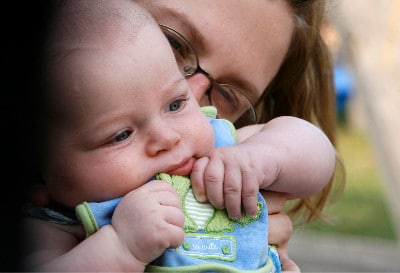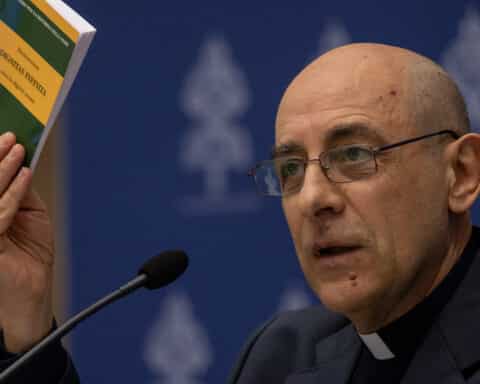“No!” That’s what many people heard from Pope St. Paul VI when he released Humanae Vitae, his encyclical on the regulation of birth. The date was July 25, 1968, right in the middle of the sexual revolution when everyone else seemed to be saying “yes” — yes to temporary marriages, yes to divorce, yes to artificial birth control. The pope was not surprised by the reaction. He wrote in the encyclical: “Not everyone will easily accept this particular teaching” (No. 18). It may be the understatement of the 20th century.
Context

Leading up to the promulgation of Humanae Vitae, popular opinion took it for granted that Pope Paul VI would decide in favor of the use of artificial means to regulate birth. Those anticipating a change to “the moral doctrine on marriage constantly taught by the magisterium of the Church” (No. 6; cf. Casti Connubii, No. 56; Gaudium et Spes, No. 51), a doctrine grounded in sacred Scripture (cf. Gn 1:28), based their confidence on the report of the commission convened by Pope St. John XXIII in 1963, and later confirmed and expanded by Pope Paul VI, “to examine views and opinions concerning married life, and especially on the correct regulations of births” (No. 5). The commission’s mandate was to advise the pope.
Members of the commission “included married couples as well as many experts in the various fields pertinent to these questions” (No. 5). Their report, meant for the pope, was leaked to the press in 1967, and many people learned about the commission’s recommendation that the Church’s ban on artificial birth control should be lifted. However, members of the commission were not in agreement on the recommendation, and Pope Paul VI was distressed that some of the “approaches and criteria for a solution” put forward were not in agreement with the constant teaching of the Church (No. 6). The pope decided to reject the commission’s recommendation and give a full account on why the teaching could not change.
Content
The basic teaching of Humanae Vitae is clear: “the direct interruption of the generative process already begun and, above all, all direct abortion, even for therapeutic means, are to be absolutely excluded as lawful means of regulating the number of children” — this includes direct sterilization (No. 14). All Christian denominations, from the beginning of the Church to 1930, held this teaching in common.
In 1930, the Lambeth Conference — which is a periodic convening of the bishops of the Anglican Communion — ruled for its members that the use of artificial birth control within marriage (they condemned sex outside of marriage) could be tolerated if the husband and wife made their decision in light of Christian principles and not from motives of “selfishness, luxury or mere convenience.” Two motives, in particular, seemed to be acceptable: not contributing to overpopulation and avoiding destitution within the family.
Read more from our Church Document series here.
Pope Pius XI responded for the Catholic Church with his encyclical Casti Connubii (Dec. 31, 1930), in which he said that any positive endorsement of artificial birth control would be based on “the false principles of a new and utterly perverse morality” (No. 3), especially considering that the married couple already has recourse to “virtuous continence” (No. 53).
Almost 40 years later, Pope Paul VI faced growing clamor to bring the Catholic Church’s position in line with experts and popular opinion, and Catholics increasingly joined the chorus for change. Population control, the good of the spouses and the responsible spacing of children so that a family did not have more children than they could afford remained the primary reasons people gave for wanting to use artificial birth control.
The pope took the concerns seriously, and he stated in Humanae Vitae that they deserved from the magisterium “a new and deeper reflection on the principles of the moral teaching on marriage.” He stated further that the magisterium was given the duty by Jesus Christ to interpret “the whole moral law,” which includes “the law of the Gospel” and “the natural law,” in order that human beings might perceive “the will of God” (No. 4).
The doctrinal principles concerning marriage are set forth in paragraphs 7-18 of Humanae Vitae. Grounding them all is the truth of faith that God is the Creator. In his loving design for marriage, God made complementary human beings, male and female, who are called to collaborate, freely and responsibly, with God in the transmission of human life.
In order to understand the truth about marriage and the regulation of birth, therefore, one must consider not only their “natural, earthly” aspects but also their “supernatural, eternal” aspects (No. 7).
Husband and wife “are not free to act as they choose in the service of transmitting life” but must do what “corresponds to the will of God the Creator” (No. 10). Certainly they must be aware of the proper functions of the biological processes involved, but the couple must exert control over them through their reason and will (cf. No. 10). Moreover, in spacing children, or practicing responsible parenthood, the couple may use lawfully only those means that nature supplies — namely, periodic continence or recourse to infertile periods. The use of artificial means obstructs “the natural development of the generative process” (No. 16).

The supernatural aspects of marriage uplift the couple and aid them in following God’s design. Guided by Scripture and Tradition (cf. Mt 19:6), the couple unite themselves in the bond of marriage by an act of free will and not merely by instinct or emotion. Husband and wife understand that in order to remain united and give birth to children responsibly, their love must be condition-free, faithful until death and open to children. Such a union is difficult but not impossible when the man and woman cooperate with each other. When husband and wife are married in Christ, who raised marriage to a sacrament, Christ strengthens the couple with his grace.
Humanae Vitae, based on the natural and supernatural aspects of marriage, declares that marriage lived according to God’s design exhibits two inseparable qualities: “the unitive and the procreative” (No. 12). The total and lasting fidelity of the spouses supports the birth and education of a child, who is best served by a father and mother making every effort to live by a sacrificial and fruitful love. A conjugal act imposed on a spouse dishonors the unitive quality just as a conjugal act that obstructs pregnancy dishonors the procreative quality (cf. No. 13). Moreover, in choosing to engage in contraception, one sets one’s will against the basic human good of procreation. That’s why Humanae Vitae reaffirms the ban on artificial birth control and teaches “that each and every marital act must of necessity retain its intrinsic relationship to the procreation of human life” (No. 11).
Call
The teaching of Humanae Vitae remains as unpopular today as it was in 1968. Its unpopularity, however, does not mean that the teaching is any less true. In fact, the rejection of Humanae Vitae’s teaching and the consequences that have followed may be the strongest proof of its prescient and prophetic vision.

Consider what has happened since the 1960s with the full acceptance and wide use of artificial birth control, even up to the present moment. Proponents of artificial birth control wanted to control the rapid increase in global population, to undergird the union of the spouses and to prevent families from existing in destitution. In each instance, the opposite has happened. The birth rate is so low in some countries that public authorities are creating incentives for couples to have more children. China, which has used forced abortions, is the most obvious example. Marital infidelity is at an all-time high, and divorce and single parents (mostly mothers) are common features of family life. Poverty, too, still plagues millions of people. One could add, as Humanae Vitae does, the objectification of women and the danger of public authorities forcing contraceptive methods on their citizens.
The Catholic Church’s call to its members, and to all people of goodwill, is basically to follow God’s will in the matter of transmitting human life, as in all matters. It is difficult to follow God’s will, but such is his love for us that he commands us to do nothing that we cannot do with his gifts and grace to help us. Embracing God’s design for marriage and the regulation of birth confers many benefits: mastery over one’s natural drives and emotions, cooperation and communication between spouses, a loving environment to raise children and a salutary influence on society. When considered with the eyes of faith, Humanae Vitae is not a “no” to human beings but an enthusiastic and life-affirming “yes!”
David Werning writes from Virginia.





